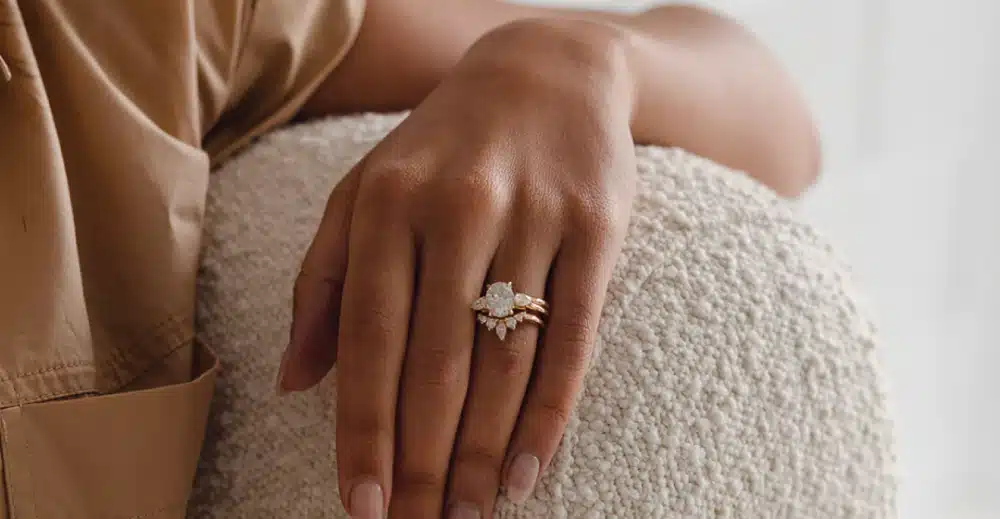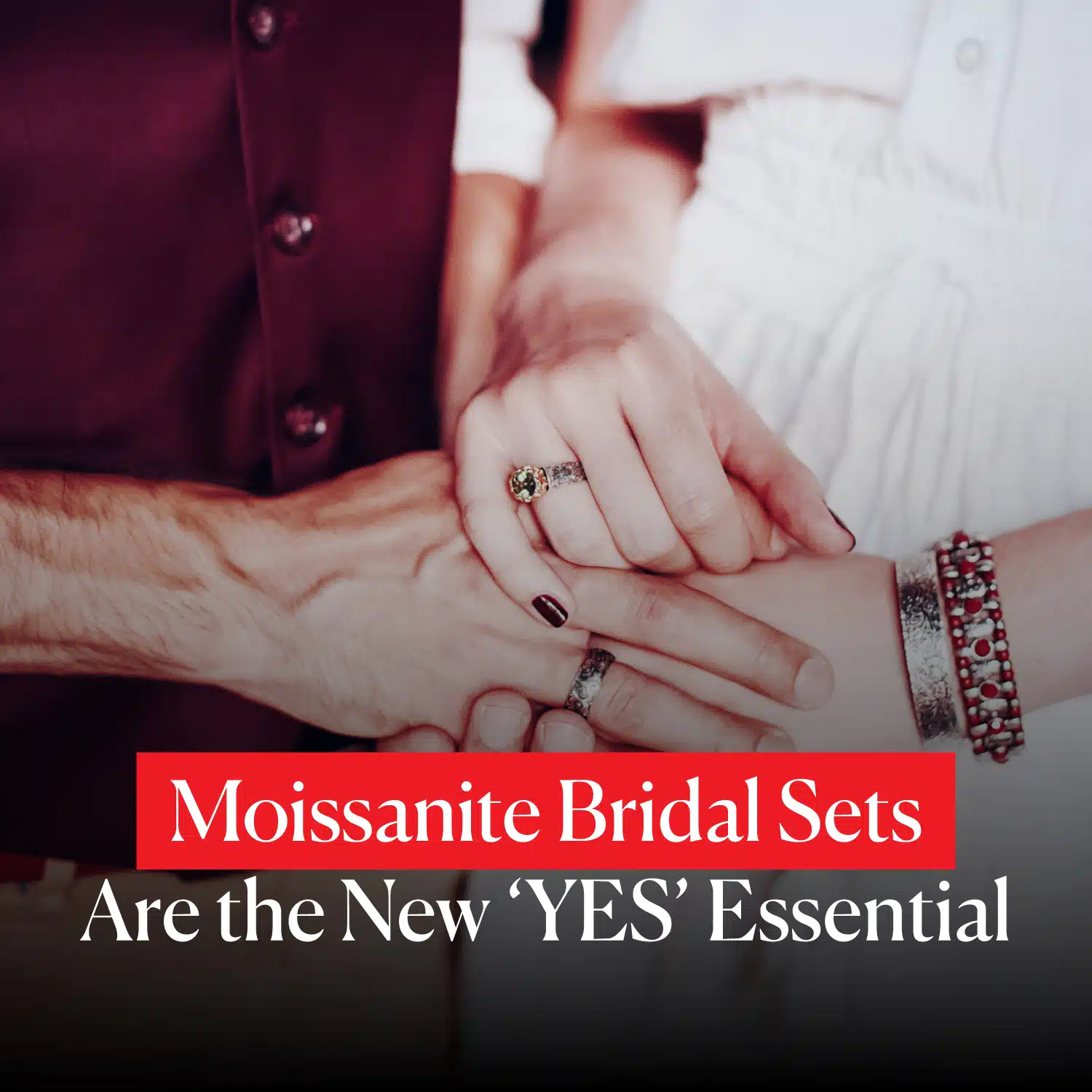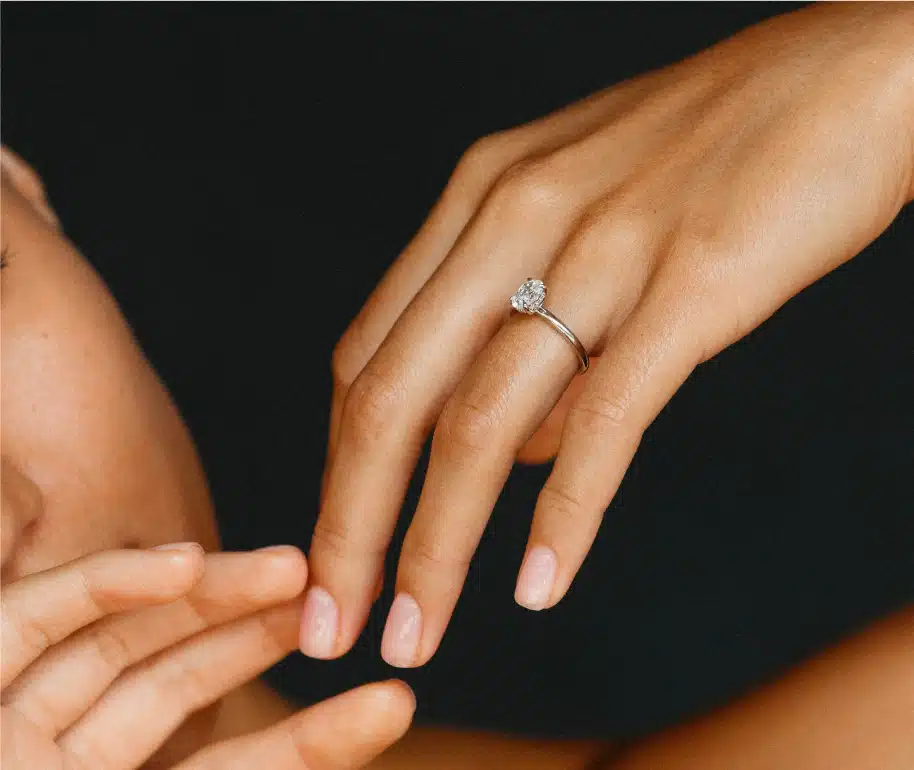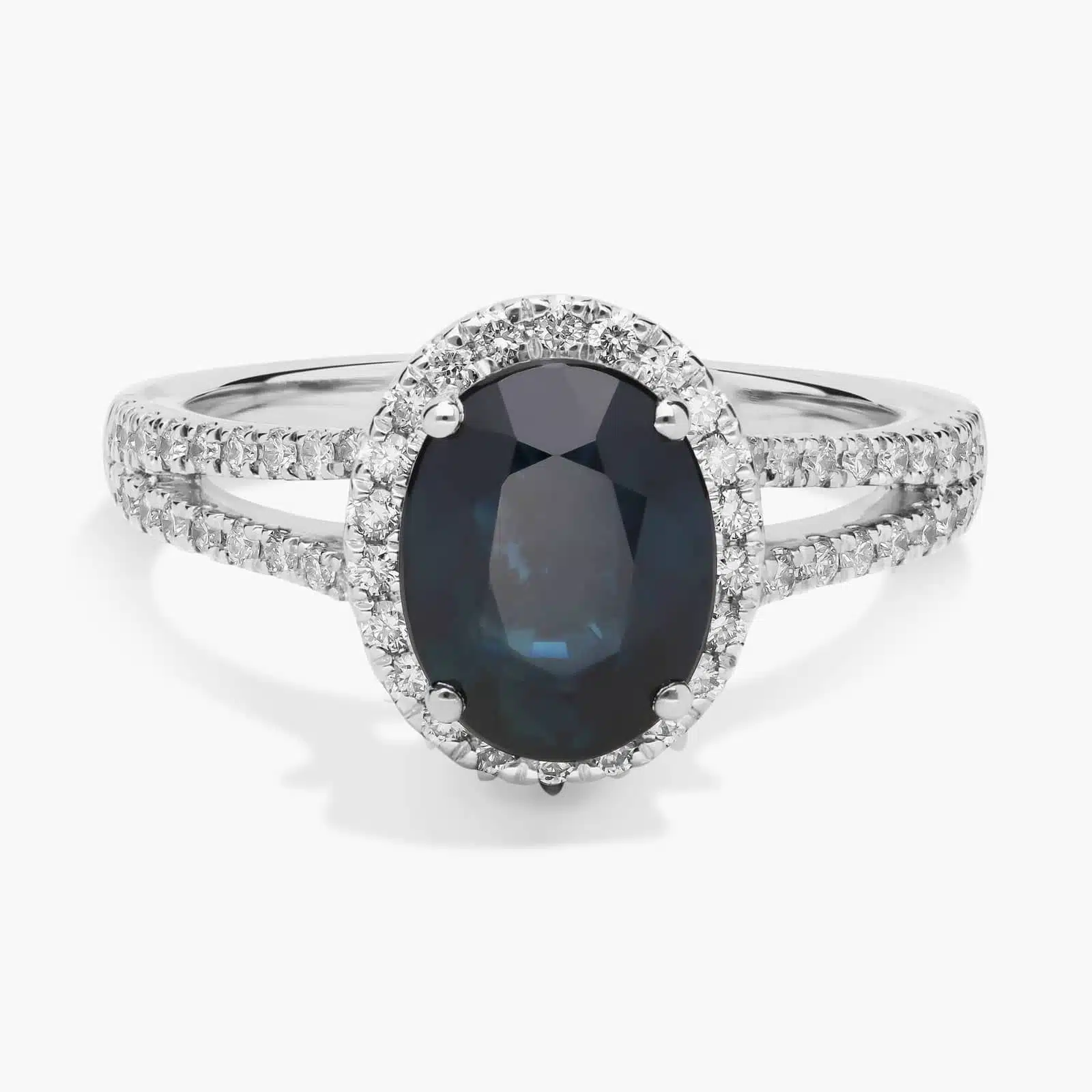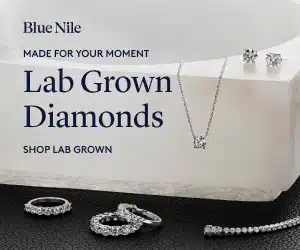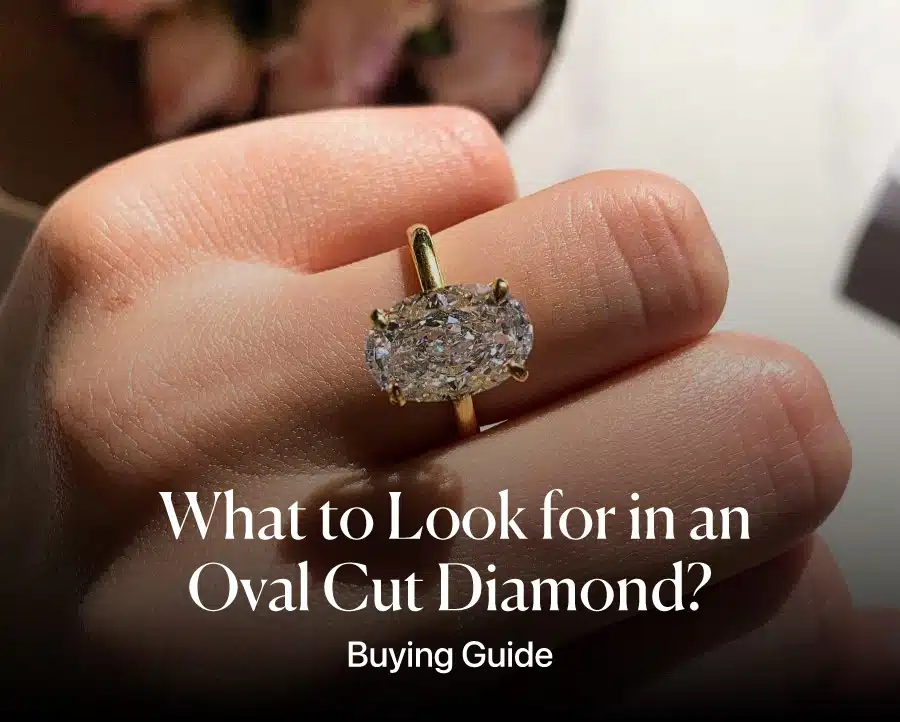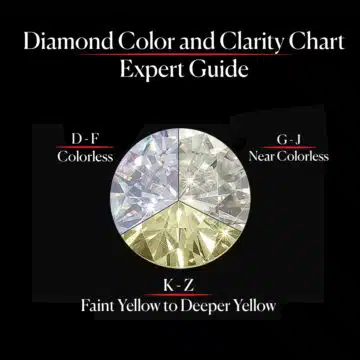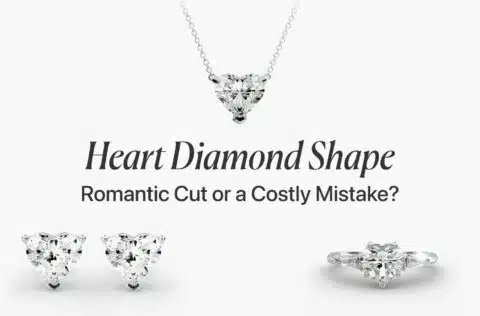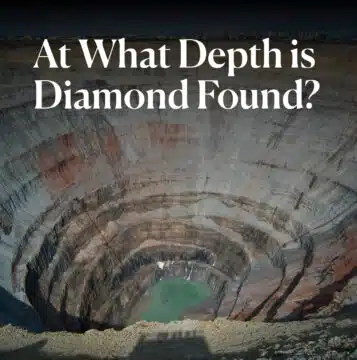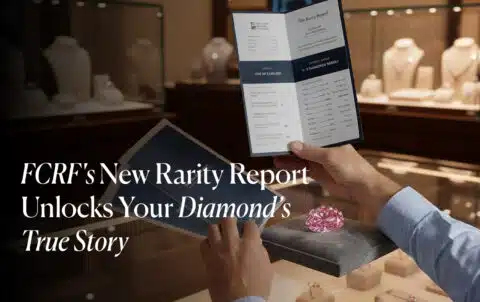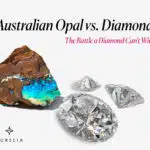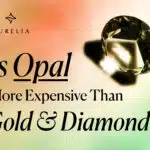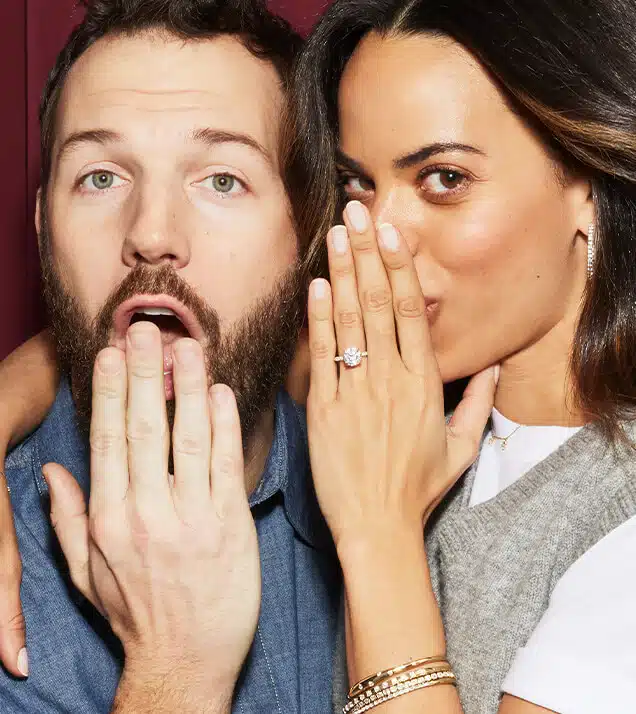The most important things to look for in an oval cut diamond are a brilliant sparkle across the entire stone, a pleasingly symmetrical shape, and the absolute minimum or complete absence of a dark “bowtie effect” in the center.
Now, let’s be blunt: GIA, the world’s top diamond lab, does not give a Cut grade for oval diamonds. This means you’re buying one of the most popular and expensive gems on earth without the most important piece of information on its certificate. It can feel like you’re flying blind, and that’s a genuinely nerve-wracking position to be in.
That’s why I’m here. As your friend in the business, my mission is to give you my eyes. This guide isn’t a list of specs; it’s an actionable blueprint to judge an oval’s beauty and performance for yourself. We will cover every detail, fill every gap, and by the end, you’ll be able to buy with total confidence.
- The Allure of the Oval: Why is Everyone Falling in Love with This Shape?
- The #1 Thing You MUST Look For in an Oval Cut Diamond
- My 4-Step Process for Evaluating an Oval Like a Pro
- How Does the Oval Stack Up Against Other Popular Shapes?
- Should Your Oval Diamond Be Lab-Grown or Natural?
- What Will an Oval Diamond Cost You (And How Big Will it Look)?
- How to Frame Your Masterpiece: Top Setting Styles for Ovals
- Your Final Questions, Answered by an Expert
- The Verdict: Become the Expert and Buy with Confidence
Diamond IQ Test: Natural or Lab-Grown?
Two identical diamonds: GIA Certified, 1.51ct, D Color, VVS1, Ideal Cut. One is natural ($16,530), the other is lab-grown ($2,390). Choose the diamond you like better and see if you can match it to its origin.
The Allure of the Oval: Why is Everyone Falling in Love with This Shape?
If you’ve found yourself drawn to oval cut diamonds lately, you’re in good company. From celebrities on the red carpet to the ring your recently-engaged friend is flashing, ovals are having a serious, well-deserved moment. But let me be clear: this isn’t just some fleeting trend.
The surge in popularity for the oval cut is rooted in three very specific, data-backed advantages that make it one of the absolute smartest choices for a modern engagement ring.
As your friend in the business, I want to pull back the curtain and show you exactly why this stunning cut is more than just a pretty face.
You Get a Bigger Look for Your Budget (The “Finger-Coverage” Factor)
Let’s start with the most exciting reason people are flocking to ovals: you get a serious bang for your buck in the size department. An oval cut diamond will almost always appear significantly larger than a round diamond of the very same carat weight, and this isn’t just a feeling—it’s a matter of pure geometry.
A diamond’s carat is a measure of weight, not of its visible dimensions. Because of the way an oval is cut, it has a larger top-down surface area, what we in the trade call its “face-up size” or “spread.” Think about it: a typical 1.00-carat round brilliant diamond might have a diameter of around 6.4mm.
A well-proportioned 1.00-carat oval, on the other hand, could easily measure 7.7mm by 5.7mm. That extra 1.3mm in length creates a massive visual impact on the finger.
Statistically, an oval can look up to 10% larger than its round counterpart, meaning your 1.00-carat oval gives the impression of being a 1.10-carat stone.
This amazing optical illusion is a concept we dive deep into in our guide on what shape diamond looks the largest.
The benefit here is crystal clear: you get a ring that provides more “finger coverage” and a more impressive presence, all without having to pay for the extra carat weight.
It is, without a doubt, the ultimate savvy choice for maximizing your budget while achieving a stunning, eye-catching look.
It Has a Uniquely Flattering, Elegant Shape

Beyond just looking bigger, the very silhouette of an oval has a uniquely flattering effect. The elongated shape naturally draws the eye up and down the finger, creating a graceful line that has a subtle, slimming effect. For many people, this makes their fingers appear longer and more slender, adding an extra touch of elegance.
But it’s also about the feel of the shape. Unlike the sharp corners of a Princess or the angular steps of an Emerald cut, an oval’s soft, rounded curves give it a timeless and romantic look. This lack of sharp edges isn’t just an aesthetic choice; it also makes the diamond more durable and less prone to chipping during everyday wear.
The oval strikes a perfect balance: it’s a departure from the traditional round, offering a more unique and considered look, but its classic curves ensure it will never go out of style.
You Get Top-Tier Brilliance with a Unique Twist
Here’s a common misconception I want to clear up right now: choosing an oval does not mean you are sacrificing sparkle. In fact, an oval cut is what we call a “modified brilliant cut.”
It was designed by the same principles as the round brilliant, using 58 intricately angled facets to produce dazzling brilliance and fire.
However, the way it displays that sparkle is what makes it so special. Where a round brilliant has a uniform, almost symmetrical pattern of light, an oval’s sparkle is a bit more dynamic.
As light plays across its longer surface, it creates a gorgeous shimmering effect, sometimes referred to as a crushed ice diamond cut. This gives the diamond a distinct and vibrant personality that is just as bright as a round, but with a character all its own.
This brilliant facet pattern is also why it’s so fantastic at hiding small inclusions. The sheer amount of sparkle and light return helps to camouflage tiny internal characteristics, which is a key part of our strategy for finding the absolute best value.
You get all the performance of the classic round, but in a shape that’s more unique, looks bigger, and flatters the hand. Frankly, it’s not hard to see why everyone is falling in love.
The #1 Thing You MUST Look For in an Oval Cut Diamond
Alright, lean in for this part. If you only remember one thing from this entire guide, make it this. We’ve already established that the GIA doesn’t grade the Cut of an oval, which can leave you feeling adrift.
But there is one tell-tale sign—one visual clue—that instantly tells you almost everything you need to know about an oval’s cut quality. I’m talking about the “bowtie effect.”
Nearly every elongated fancy shape diamond, from ovals to pears and marquises, has the potential to show one. But in an oval, a bad one is a deal-breaker. Identifying and rejecting a severe bowtie is the first and most important test your potential diamond must pass.
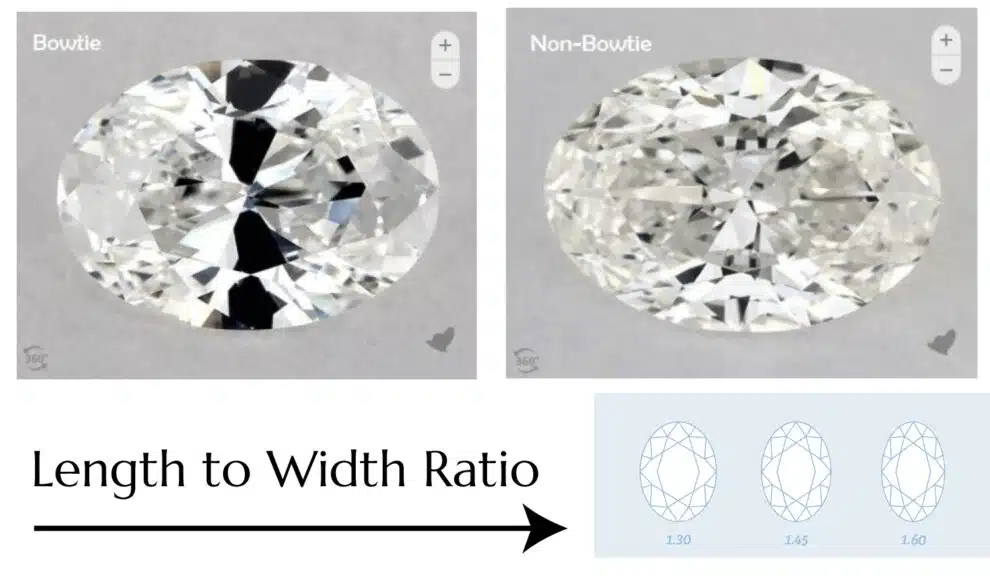
DIAMOND ON SALE!!
⏰ Tick-Tock! The Best Diamond Deals at James Allen Are Disappearing Fast!
What is the Bowtie Effect?
Let’s get straight to it. The bowtie effect is a dark, bowtie-shaped shadow that can appear across the center of an oval diamond.
It is absolutely crucial to understand that this is not an inclusion. It’s not a black mark or a flaw within the diamond itself. The bowtie is an optical illusion, a shadow created by light (or the lack thereof). Imagine the pavilion (the bottom, cone-shaped part of the diamond) is a complex system of mirrors.
In a perfectly cut oval, these pavilion facets are angled with such precision that they catch the light and reflect it right back to your eye.
But if those crucial center facets are even slightly misaligned—cut too deep or too shallow—they fail to do their job. Instead of reflecting light, they create a dead zone where the light escapes out of the bottom of the stone.
When you look at the diamond from the top, you are seeing a direct reflection of the dark shadow of your own head and shoulders where the light should be. That shadow is the bowtie.
Why a Bad Bowtie is a Deal-Breaker
I need you to be very clear on this: a severe, dark bowtie is a permanent and unfixable feature of the diamond. It’s the clearest sign of a mediocre to poor cut.
No amount of cleaning or special lighting will ever make it go away. It is a dead zone, right in the heart of your diamond, that will kill its sparkle from every angle.
Think of it like buying a brand new, high-definition television. If that TV had a permanent dark bar running across the middle of the screen, you wouldn’t even consider buying it, no matter how good the specs were on paper. The same goes for an oval diamond.
A prominent bowtie will always be the first thing your eye is drawn to, forever distracting from the stone’s potential beauty. A diamond is a vessel for light, and a severe bowtie is a permanent leak. You must never, ever accept it.
The Mehedi Method: How to Spot and Reject a Bowtie in 30 Seconds
The great news is that you don’t need to be a gemologist to spot a bad bowtie. You just need to know what to look for, and the high-definition, 360-degree videos provided by good online vendors are your most powerful tool. Here is my exact process:
- 1. Look at it Face-Up, Dead On. Before you even start the video, look at the static image. Is there a noticeable dark shape right across the middle?
A faint one is common and often acceptable, but if it looks like someone took a black marker to the center of the stone, that’s your first major red flag. - 2. Watch the Video and Tilt. Now, play the 360-degree video. As the diamond turns, pay close attention to the center. Does that dark bowtie shadow stay stubbornly dark from every single angle? Does it dominate the stone, making it feel less brilliant?
- 3. Judge the “Life” of the Stone. A truly well-cut oval won’t be completely free of contrast—that’s what makes a diamond interesting. However, as it tilts, the dark areas should shrink, light up, and dance around.
The key is that the light should be able to “get into” the center of the stone and make it sparkle. If the bowtie remains a persistent, unchanging dark shape that never seems to catch the light, then you have your answer.
That’s a “No” diamond. It’s a hard pass. Don’t try to talk yourself into it. Don’t hope it will look better in person. Your search for this specific diamond is over.
The beautiful thing about today’s market is that there are thousands of other stones to choose from. By rejecting the duds, you get one step closer to finding the truly spectacular one.
Read Our 5-Star Blue Nile Review
Check our comprehensive Blue Nile review to learn why we rated Blue Nile 5 stars for their exceptional quality and value.
My 4-Step Process for Evaluating an Oval Like a Pro
So, how do you actually judge an oval diamond’s cut when the GIA certificate doesn’t give you a grade? You do it by following a clear, logical process. Forget trying to analyze everything at once.
This is the exact four-step blueprint I use to evaluate any oval diamond. Follow these steps in this order, and you’ll be able to confidently separate the duds from the spectacular stones.
Step 1: It MUST Pass the Bowtie Test
I cannot stress this enough: this is your gatekeeper. Before you even look at the clarity, the color, or the carat weight, you must put the diamond through the bowtie test we just covered.
If you spot a severe, dark, and persistent bowtie that kills the light in the center of the stone, your evaluation of that diamond is over. It’s a “No.” Reject it and move on to the next one.
A beautiful oval can have a faint, minimal bowtie that comes and goes as it moves, but it should never be a distracting dead zone. This is your most important non-negotiable.
Step 2: Judge the Shape (The Length-to-Width Ratio)
Once a diamond has passed the bowtie test, the next thing to consider is its overall silhouette. The “Length-to-Width Ratio” (L/W) sounds technical, but it’s simply a number that tells you how chubby or slender the oval is. You calculate it by dividing the diamond’s length in millimeters by its width.
This isn’t about “good” or “bad”; it’s about your personal preference. Knowing these numbers helps you filter for the exact look you love:
- 1.30 and below: This is a wider, “chubbier” oval. Some people love this full, rounder look.
- 1.35 – 1.50: This is the classic “sweet spot.” This range is what most people picture when they think of an oval diamond. It’s the most popular and traditionally sought-after shape.
- 1.51 and above: This is a longer, more slender oval that starts to approach the look of a marquise cut. It can create an exceptionally elongated look on the finger.
There is no right answer here, but knowing your preference will save you a ton of time. Look at a few examples and decide which style you’re drawn to before you start your serious search.
Step 3: Check the Key Proportions (Your Expert Starting Point)
This is the part that can feel the most intimidating, but I’m going to make it simple. While there’s no magic formula for a perfect oval like there is for a round, there are certain geometric proportions that tend to produce a brilliant, lively diamond.
The table below isn’t a strict rulebook; think of it as my personal cheat sheet—an expert guideline to help you get in the right ballpark.
| Proportions | My Recommendation (The “Sweet Spot”) | Why It Matters (The Simple Version) |
| Table % | 53-63% | This is the main “window” of the diamond; too large or too small can hurt its sparkle. |
| Depth % | 58-62% | Too shallow and the stone looks glassy; too deep and the light gets trapped and dies. |
| Girdle | Thin – Slightly Thick | This is the “edge” of the diamond. Extremely thin can risk chipping. |
| Culet | None | A “culet” is a facet on the bottom tip. A pointed tip (None) is ideal for modern ovals. |
Use these numbers as your starting filter, but always remember that for an oval, your eyes are the final judge. A diamond could fall just outside these ranges and still be stunning, or fall within them and have a terrible bowtie. This is a guide, not a guarantee.
James Allen: Our 5-Star Choice for Price and Selection
Check our comprehensive James Allen Review to learn more about their pricing and commitment.
Step 4: Find the Smartest Value in the 4Cs
You’ve found a diamond that passed the bowtie test, is in the shape you love, and has good general proportions. NOW, and only now, do you start to play the value game with Color and Clarity to save yourself a ton of money.
Color (My Recommendation: H or better)
An oval’s brilliant facet pattern is great at concealing color in the main body of the stone, but color can be more noticeable near the pointed tips.
For this reason, my go-to recommendation for a stone that will look icy-white in a platinum or white gold setting is an H Color Diamond.
It offers phenomenal value and is the perfect sweet spot. You can browse thousands of them with 360-degree videos on sites like James Allen.
Clarity (My Recommendation: SI1 or SI2)
This is the single smartest place to save money on an oval diamond. Their “crushed ice” look is an absolute master at hiding small imperfections.
There is almost never a reason to pay the massive premium for a VVS or Flawless oval when you can find a completely “eye-clean” one for a fraction of the price. An “eye-clean” diamond is one that has inclusions that are only visible under magnification, not to your naked eye.
Finding one is the ultimate smart buy, and our guide to SI1 clarity diamonds shows you exactly what to look for.
How Does the Oval Stack Up Against Other Popular Shapes?
It’s one thing to love the oval in a vacuum, but the real question is, how does it stack up against the other top contenders? Most people I work with are trying to decide between an oval, the classic round brilliant, and the popular cushion cut.
Let’s put them head-to-head. Seeing how they compare on the things that actually matter—what you see and what you pay—is the best way to be 100% confident in your choice.
Visual Size: Who Wins on “Finger Coverage”?
- Oval: The clear winner. Its elongated shape and large top surface area give it the best “spread” of any shape. A 1-carat oval will look noticeably larger on the finger than a 1-carat round or cushion.
- Round Brilliant: Looks true-to-weight. A lot of its carat weight is in its depth, which is necessary for its perfect sparkle, but it means you get a smaller face-up size compared to an oval.
- Cushion: This one is a bit tricky. Cushions tend to be cut quite deep, which means they often look a little smaller than even a round diamond of the same carat weight.
If your absolute #1 priority is getting the biggest-looking diamond for your budget, the oval is your champion. No contest.
Sparkle Level: What’s the “Wow” Factor?
- Oval: Exceptional, brilliant-style sparkle. Because of its longer shape, it produces what many people describe as a “crushed-ice” look, with tons of shimmering flashes across the stone. It’s incredibly lively and bright.
- Round Brilliant: This is the scientific benchmark. A well-cut round brilliant has the highest level of brilliance (white light return) of any diamond shape, period. Its sparkle is uniform, fiery, and explosive.
- Cushion: Also a “crushed-ice” style sparkle, similar to an oval but in a squarer or more rectangular shape. It’s a gorgeous, fiery look that is beloved for its romantic, vintage feel.
The round is technically the most brilliant, but you are not sacrificing sparkle with an oval or a cushion. It’s simply a different “flavor” of sparkle. If you love that dynamic, shimmering effect, the oval is a perfect choice.
Price: Who Offers the Best Value?
- Oval: Excellent value. Because cutters can use a larger portion of the original rough diamond when creating an oval, the final price is often 20-30% lower than a round brilliant of the same carat and quality.
- Round Brilliant: The highest price-per-carat. The combination of intense demand and low yield from the rough stone (lots of waste) makes it the most expensive shape.
- Cushion: Very good value. Similar to ovals, the cutting process for a cushion is more efficient than for a round, making it a much more budget-friendly option.
Both the oval and the cushion offer fantastic value. The oval gives you that bigger look, while the cushion gives you a different silhouette, but both are much smarter buys than a round brilliant if your budget is a primary concern.
To make it even clearer, here’s the bottom line in a simple table:
| Feature | Oval Cut | Round Brilliant | Cushion Cut |
| Visual Size | Looks Largest | True-to-Weight | Looks Smaller |
| Sparkle Level | Exceptional | The Highest | “Crushed-Ice” Sparkle |
| Price | Excellent Value | Highest Price | Good Value |
| Durability | No sharp corners | No sharp corners | Rounded corners |
Best Deal Of The Year – Final Days
Blue Nile’s “Clear The Vault” is ON.
Shop Fine Jewelry Upto 70% OFF.
*Exclusions may apply. See Blue Nile for complete details.
Should Your Oval Diamond Be Lab-Grown or Natural?
Alright, let’s talk about the biggest and most important new question in the diamond world: should you choose a lab-grown or a natural oval diamond? Ten years ago, this wasn’t even a conversation.
Today, it’s one of the first decisions you need to make, and it’s a game-changer for your budget and your options. As your friend in the business, I’m not here to push you one way or the other. I’m here to give you the straight facts so you can make the choice that feels right for you.
First, let’s be crystal clear on what a lab-grown diamond is. It is not a fake diamond. It is not a simulant like cubic zirconia.
A lab-grown diamond is 100% a real diamond, identical to a mined diamond in every single way—it has the same chemical, physical, and optical properties. The only difference is its origin. One came from under the earth, and the other came from a highly advanced lab.
The Case for a Lab-Grown Oval Diamond
The Cost Savings are Immense
This is the headline, and it’s impossible to overstate. A lab-grown oval diamond will cost you anywhere from 50% to 70% less than a natural diamond of the exact same size and quality. Let me say that again.
You can get a jaw-dropping, high-quality 2-carat lab-grown oval for the price of a good 1-carat natural oval. This is a financial game-changer that allows you to get a much larger and higher-quality stone than you ever thought possible, or simply save thousands of dollars for your wedding, a house, or your future.
It’s Easier to Find a Great One
This is a huge insider tip specifically for ovals. Since we know GIA doesn’t grade an oval’s cut and a bad bowtie is a deal-breaker, your best tool is having a large selection to choose from.
The lab-grown market is booming, which means there is a much larger inventory available. This gives you a statistically much better chance of finding a beautifully cut, bowtie-free oval that meets all of your criteria.
Guaranteed Ethical Origin
With a lab-grown diamond, there are zero questions about its origin. For a deep dive, check our guide on the types of lab-grown diamonds.
You have a 100% guarantee that it is ethically sourced and has a minimal environmental footprint, which provides incredible peace of mind for many couples.
The Case for a Natural Oval Diamond
Long-Term Value and Rarity
This is the most significant reason to choose a natural diamond. As a finite, natural resource that took billions of years to form, a natural diamond holds a portion of its monetary value over time and has a history of appreciation.
Lab-grown diamonds, which are a product of technology that is constantly improving and becoming cheaper, have very little to no resale value. A natural diamond is a rare geological treasure; a lab-grown diamond is a marvel of modern technology. You’re buying into two very different concepts of value.
The Romance and Tradition
For many people, a diamond is a powerful symbol precisely because it’s a rare and ancient creation from the earth. There’s a romance and a tradition tied to natural diamonds that is deeply meaningful.
For some, the story of a diamond that is billions of years old is an inseparable part of its allure. This is a purely emotional reason, but it’s a very real and valid one.
My Honest Advice
This isn’t a battle of “good” vs. “bad.” It’s a choice based on your personal priorities. If your goal is to maximize your budget for the biggest and best-quality diamond you can get right now, a lab-grown oval is an absolutely fantastic and savvy choice.
If you value long-term financial worth and the romance of owning a rare piece of the earth, then a natural diamond is the right choice for you.
Many top vendors now offer both, allowing you to see the price differences for yourself. At a site like Ritani, you can easily compare a natural and a lab-grown oval with the same specs side-by-side, which is an incredibly powerful tool for making your final decision.
What Will an Oval Diamond Cost You (And How Big Will it Look)?
Alright, let’s talk about the two biggest questions for every buyer: how much is this going to cost, and how big will it actually look on my finger? The oval diamond shines in both of these areas, and I want to show you exactly how and why, so you can make a truly informed decision.
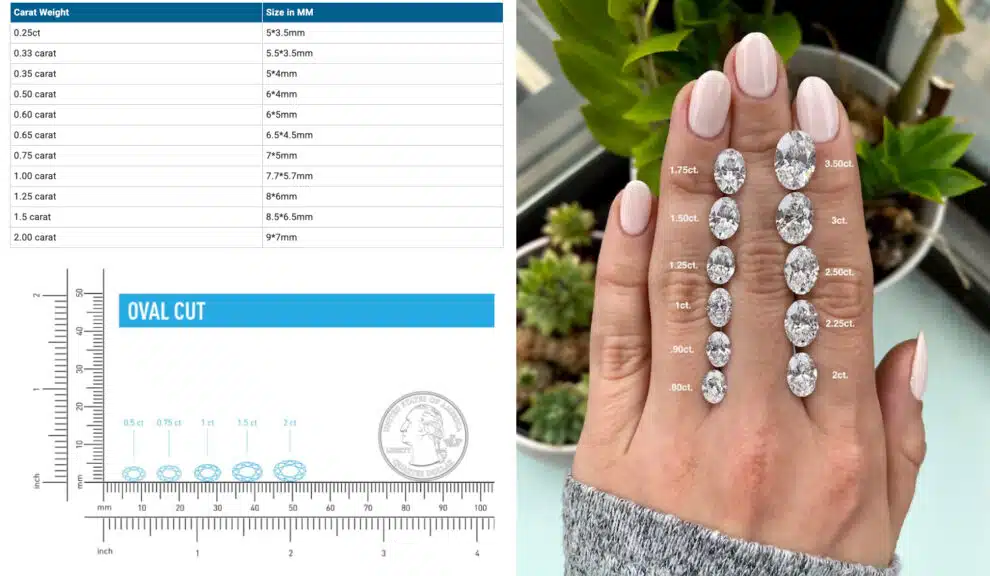
Price Analysis: Why Ovals Offer Such Incredible Value
I’ve mentioned that ovals are a smarter buy, but let’s look at the hard numbers. On average, a beautiful, well-cut oval diamond is about 20-30% less expensive than a round brilliant diamond of the exact same carat weight and quality.
Why the huge price difference? It all comes down to the diamond cutter. When a cutter starts with a rough diamond crystal, their goal is to preserve as much of that precious material as possible.
To create the perfect mathematical proportions of a round brilliant, they often have to grind away more than 60% of the original stone—that’s a lot of waste that you ultimately pay for.
The elongated shape of an oval, however, allows the cutter to follow the natural shape of many diamond crystals more closely, preserving more of the original carat weight.
Simply put, you’re paying for the finished product, not for the part of the diamond that ended up as dust on the cutting room floor.
Here’s a look at what you can expect to pay for a high-quality (H Color, VS2 Clarity) oval diamond at popular carat weights. Notice how the “Price Per Carat” isn’t a flat number—it jumps significantly at those milestone marks.
| Carat Weight | Typical Price | Price Per Carat (Approx.) |
| 1.00 Carat | ~$3,500 | $3,500 |
| 1.50 Carat | ~$8,000 | $5,330 |
| 2.00 Carat | ~$13,500 | $6,750 |
| 3.00 Carat | ~$37,000 | $12,330 |
(Note: Prices are based on current market data for natural diamonds and are for illustrative purposes. Prices can fluctuate.)
Visual Size Guide: What Carat Weight Looks Like in the Real World
This is where the oval truly becomes a superstar. Before we look at the charts, it’s crucial to remember this: carat is a measure of weight, not size. A 1.00-carat diamond weighs 0.2 grams. How big that diamond looks depends entirely on how it was cut and its shape.
Because of its elongated silhouette and larger top surface area, an oval will always look bigger than a round diamond of the same weight. The chart and images below give you a fantastic real-world sense of how different carat weights will look on a finger and relative to a familiar object.
(I will place the “Oval Diamond Size Chart” and the “Hand/Quarter Comparison Images” here.)
Use this guide to find the carat weight that matches the look you’re going for. A 1.00-carat oval gives the finger coverage of a 1.10-carat round, while a 1.50-carat can look as large as a 1.70-carat round.
This visual advantage is the oval’s secret weapon. To see how these dimensions stack up against every other diamond shape, you can check out our comprehensive Diamond Carat Size Chart for a complete comparison.
How to Frame Your Masterpiece: Top Setting Styles for Ovals
Okay, the hard part is over. You’ve navigated the tricky waters of cut quality, you know how to reject a bad bowtie, and you’ve found a stunning, brilliant oval diamond. Now for the really fun part: choosing the perfect home for it.
The setting is what gives your ring its final personality. It’s the frame that complements your diamond and makes it uniquely yours. Your oval is versatile enough to look incredible in almost any style, but let’s walk through the most popular choices and what they actually do for the look and feel of the ring.
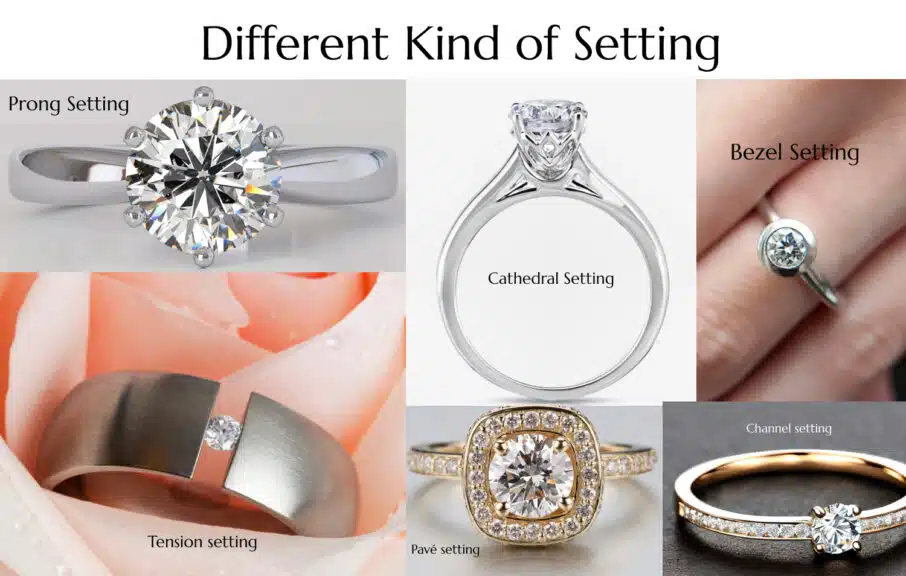
The Solitaire Setting
- Who it’s for: The timeless purist. The person who believes the diamond itself is the one and only star of the show.
- What it does for the Oval: A simple solitaire setting puts all the focus on the oval’s elegant shape and unique brilliance. With no other distractions, the eye is drawn directly to the stone’s beautiful curves and dazzling sparkle. A 4-prong setting can give it a slightly more modern, open look, while a 6-prong setting (less common for ovals, but possible) offers a bit more security.
- Pros: Classic and elegant; allows the most light to enter the diamond; easy to clean and maintain.
- Cons: Offers the least amount of protection for the diamond’s edge (the girdle).
Best Deal Of The Year – Final Days
Blue Nile’s “Clear The Vault” is ON.
Shop Fine Jewelry Upto 70% OFF.
*Exclusions may apply. See Blue Nile for complete details.
The Halo Setting
- Who it’s for: The glamour lover. The person who wants the absolute maximum “wow” factor and a bold, brilliant look.
- What it does for the Oval: A halo setting—a ring of tiny diamonds that surrounds the center stone—is like turning the volume up to 11. It takes the oval’s already impressive size and makes it look even bigger and more impactful. The extra layer of sparkle creates a seamless, jaw-dropping look of continuous brilliance.
- Pros: Makes the center diamond appear significantly larger (up to a half-carat bigger); adds immense overall sparkle.
- Cons: Can sometimes be seen as more “trendy” than “timeless”; requires more frequent cleaning to keep all the small stones sparkling.
The Three-Stone Setting
- Who it’s for: The storyteller. The person who loves symbolism and a balanced, substantial look.
- What it does for the Oval: Flanking the center oval with two smaller side stones (often pears, rounds, or trillions) creates a beautiful visual journey across the finger. It gives the ring a balanced, horizontal presence and adds a layer of design and meaning—representing your past, present, and future.
- Pros: Incredibly symbolic; creates a larger, more substantial look; allows for personalization with different side-stone shapes.
- Cons: Can be more expensive; the side stones need to be perfectly matched to complement, not compete with, the center oval.
Lifetime Protection Alert!
A James Allen purchase includes a free lifetime warranty. This covers free prong tightening, polishing, and cleaning for life, ensuring your jewelry always looks its best.
The Bezel Setting
- Who it’s for: The modern minimalist and anyone with an active lifestyle.
- What it does for the Oval: A bezel setting, where a thin metal rim perfectly encloses the diamond’s edge, frames your oval like a piece of modern art. It gives the ring a sleek, clean, and contemporary feel while offering unparalleled protection.
- Pros: This is the most secure setting, period. It protects the diamond from chipping and is completely snag-free.
- Cons: The metal rim covers the edge, which can make the oval appear slightly smaller than it would in a prong setting.
Seeing these options on a screen and pairing them with your actual diamond can make all the difference. You can experiment with different styles and build your own engagement ring on James Allen to find your perfect match.
Your Final Questions, Answered by an Expert
You’re nearing the finish line, but it’s natural to have a few more specific questions. This is a big decision, and getting clear answers is key to feeling confident. Here are my straightforward responses to the most common questions I get from clients about oval diamonds.
The Verdict: Become the Expert and Buy with Confidence
It’s true—GIA may not give you a neat little map on a certificate for an oval diamond, but that should never mean you have to buy blind. The single most important takeaway from this guide is that you now have the expert’s blueprint. You don’t need to guess or hope you’re making a good choice anymore.
By making the bowtie your first and most critical test, judging the shape with your own eyes, and being incredibly smart about finding the value in Color and Clarity, you’ve completely changed the dynamic. You’re no longer just a buyer, hoping you get it right; you’re an informed expert who is in control of the process.
Now you know exactly what to look for in an oval cut diamond.
Blue Nile is one of the biggest and most recognized online jewelry retailers, offering an extensive and exclusive inventory. Their high-resolution images are improving and getting closer to the quality offered by James Allen, while their prices remain highly competitive. Right now, Blue Nile offers up to 30% savings on jewelry during a limited-time sale.
WHAT WE LOVE ABOUT THEM:
- 30-day no-questions-asked return policy, with a prepaid shipping label provided by Blue Nile.
- Lifetime warranty on all purchases.
- Free shipping on every order.
- Complimentary services every six months, including prong tightening, repolishing, rhodium plating, and cleaning.
- Insurance appraisal included with your purchase.
- One free resizing within the first year.
- High-quality images available for roughly half of their diamond selection.
- 24/7 customer service support.
- Full credit toward future upgrades, as long as the new item is at least double the value.
- Best-in-class order fulfillment process.
James Allen is a top leader in online diamond sales, offering cutting-edge imaging technology that lets you inspect diamonds as if you were using a jeweler's loupe. With the largest exclusive selection of loose diamonds available online and excellent pricing, they also boast one of the finest collections of lab-created diamonds on the market. They currently run a 25% discount on selected lab-grown diamonds!
WHAT WE LOVE ABOUT THEM:
- 30-day no-questions-asked return policy, with a prepaid shipping label provided by James Allen.
- Lifetime warranty on all purchases.
- Free international shipping.
- Complimentary prong tightening, repolishing, rhodium plating, and cleaning every six months.
- Insurance appraisals included with purchases.
- One free resizing within 60 days of purchase.
- Free ring inscriptions available.
- Best-in-class high-quality imagery for every diamond in stock.
- 24/7 customer support.
- Premium, best-in-class packaging.

